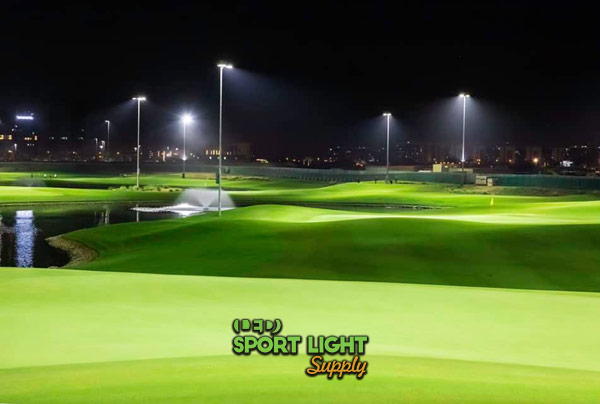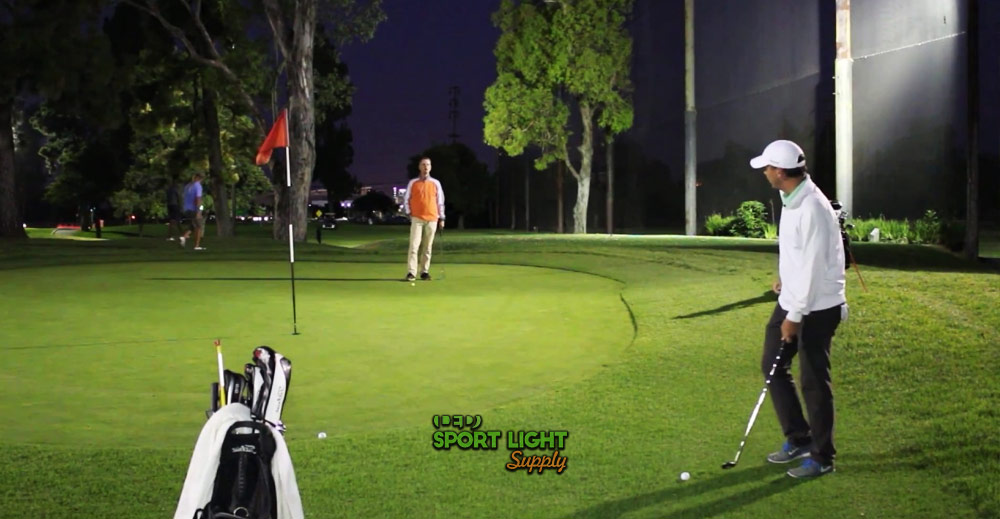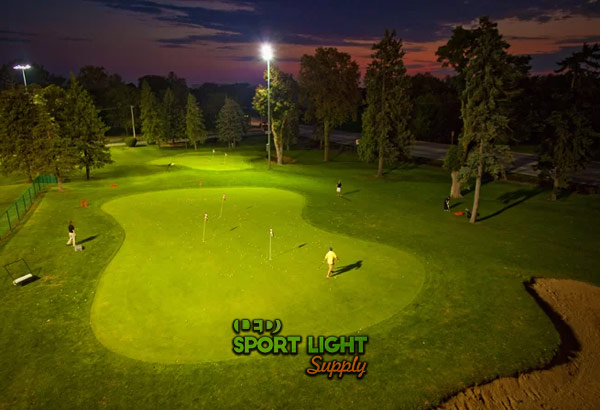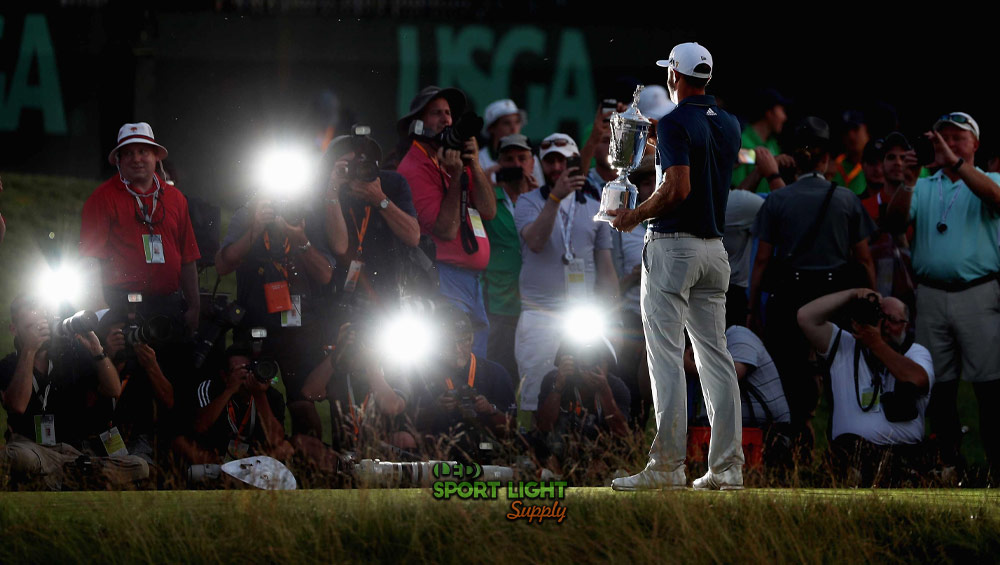In addition to the expansive fairways and open spaces found on golf courses nationwide, there is a specific standard for golf course lighting designed to facilitate nighttime play. This specialized lighting system addresses the unique needs of golf courses by employing strategically positioned light poles to effectively illuminate the wide and open areas of the course.
Table of Contents
ToggleGolf Course Lighting Standards
Lux (Footcandle)

Lux Level Requirements for Outdoor Golf Courses
Lux is the standard unit of measurement for light intensity and is often used interchangeably with footcandles. For golf courses, this measurement determines the appropriate brightness levels necessary for various activities and environments. The Lux value for golf courses is categorized based on the intended use: recreational, professional, and major tournaments.
Recreational
Municipal golf courses intended for public use fall into the recreational category. Despite their public nature, these courses are often well-designed and maintained. The recommended Lux levels for recreational driving ranges are between 100 and 300 Lux. This range is similar to the lighting found in a typical living room or office environment, providing sufficient illumination for casual play.
Professional

Professional golf courses demand higher lighting levels to accommodate players who require enhanced visibility. Lux levels for professional courses typically range from 500 to 800 Lux, which is comparable to lighting in supermarkets or libraries. This higher intensity benefits both seasoned players and those with reduced vision, ensuring optimal playing conditions during nighttime events.
National/International Tournaments
For prestigious events like the Masters Tournament or the US Open, lighting must meet even higher standards. These courses are illuminated to a level of 1000 to 2000 Lux. This intensity ensures excellent visibility for television viewers and camera equipment, providing clear and precise lighting for all 18 holes.
Lighting Uniformity
Lighting Uniformity Standards for Golf Courses
Maintaining consistent lighting across a golf course is challenging due to its expansive layout. Uniformity is crucial for ensuring that players can see the ball and their surroundings clearly.

Recreational
Recreational golf courses typically aim for a lighting uniformity ratio of 0.4 to 0.5. This level ensures that while lighting may not be exceptionally bright, it is adequate for players to navigate the course and track the golf ball effectively.
Professional
Professional courses require a higher level of lighting uniformity, ranging from 0.5 to 0.6. This improved uniformity is essential for providing a competitive advantage and accommodating players with varying visual needs. More light poles are often used to achieve this level of consistency.
International Tournaments
Golf courses hosting major tournaments such as the PGA Tour or the US Open must achieve a lighting uniformity ratio greater than 0.6, with adjacent areas also meeting this standard. This ensures high-quality illumination for both players and television broadcasts, often necessitating the use of specialized lighting platforms or portable light towers.
Color Temperature
Color temperature affects the quality of light and can impact players’ comfort and performance.
Recreational
Recreational golf courses generally use warm white lighting with a color temperature ranging from 2500K to 3500K. This warmer hue creates a more relaxed atmosphere, similar to street lighting, making it less harsh for nighttime play.
Professional
Professional golf courses typically utilize lighting with a color temperature of around 5000K. This daylight-equivalent light closely replicates natural daylight, enhancing visibility and providing a consistent visual experience for players.

Flicker-Free Lighting
For professional golf courses, especially those hosting televised tournaments, lights must be flicker-free at frequencies of 10,000Hz or higher. This standard is crucial for capturing high-quality slow-motion footage of the golf ball and player actions.
Glare Rating
Minimizing glare is essential to ensure that lighting does not interfere with players’ ability to see clearly. For professional courses, a glare rating of greater than 50 is typically targeted to keep glare to a minimum, although recreational courses also strive for effective glare management.
Lifespan
Different types of outdoor lighting have varying lifespans, which influences their selection for golf courses.
| Lighting Type | Lifespan |
|---|---|
| LED Lights | Up to 150,000 hours |
| Mercury Vapor Lamps | 10,000 – 20,000 hours |
| Metal Halide Lamps | 5,000 – 20,000 hours |
LED lights are preferred for their longevity and cost-effectiveness, making them a popular choice for golf course lighting.
Spill Light and Light Pollution
Reducing Light Pollution on Golf Courses
Minimizing light pollution is crucial for preserving the quality of the golf course environment and preventing excessive spill light.
Using Smaller Beam Angles
Smaller beam angles can be beneficial for tall light poles by focusing light more precisely, reducing spill light. This approach is effective on flat areas but less suitable for uneven landscapes.
Shorter Light Poles
Installing shorter light poles can help reduce light spill but may require additional poles to cover the entire course. Careful planning is needed to avoid obstructing the playing area.
Using More Light Poles
Increasing the number of light poles can help manage light distribution but must be done thoughtfully to avoid interfering with play. Each golf course requires a customized lighting design to balance illumination and pole placement.
Adding Barn Doors on Flood Lights
Barn doors, adjustable metal shutters on flood lights, help control light spill by shielding unnecessary glare. This solution is particularly useful for taller light poles and helps manage light distribution effectively.
Common Specifications of Golf Course Lighting
When selecting lighting for golf courses and driving ranges, it’s essential to consider several key specifications to ensure optimal performance and longevity. Here are some important factors to keep in mind:
Luminous Efficiency
For LED lighting, a luminous efficiency greater than 150 Lumens per Watt (lm/W) is ideal. Luminous efficiency refers to the amount of light output (in lumens) per unit of power consumed (in watts). LED lights are known for their superior luminous efficiency compared to other lighting types. This efficiency allows LEDs to deliver more light while consuming less power, making them a preferred choice for golf course lighting.
Power and Lumen Output
Power alone does not determine the brightness of a light; instead, focus on the lumen output. For LED lights, the lumen output indicates how bright the light will be. Unlike traditional incandescent lights, where wattage often correlates with brightness, LED lights require a different approach. For instance, a 100-watt incandescent light does not produce the same light output as a 100-lumen LED light. Therefore, always check the lumen rating to gauge the brightness needed for your application.
Beam Angle
Beam angles for golf course lighting typically range from 15 to 90 degrees. Lower beam angles, such as 15 or 22 degrees, are suited for tall light poles, as they allow light to cover a larger area from a higher position. Wider beam angles, like 45, 60, or 90 degrees, are used for shorter poles and help reduce light flare and pollution. Selecting the appropriate beam angle ensures effective illumination while minimizing unwanted light spill.
Color Temperature
Color temperature affects how well players can see the course and the golf ball. For recreational courses, warmer color temperatures between 2500K and 3500K, similar to filament lamps, are typically used. These temperatures create a softer light that is easy on the eyes. For professional courses, especially those used for television broadcasts, a higher color temperature of around 5000K is preferred. This daylight-equivalent light ensures clear visibility and accurate color reproduction for both players and cameras.
Power Supply
A high-quality power supply is crucial for the reliable operation of lighting fixtures and floodlights. Brands such as MeanWell and Inventronics are known for their durability and superior thermal performance. A dependable power supply ensures that LED lights and other lighting systems operate efficiently and have a long lifespan. When selecting a power supply, prioritize reliability and long-term performance.
Lighting Protection
Golf courses, particularly in regions prone to thunderstorms, require adequate lightning protection. Lighting fixtures should be grounded, and each light pole should have a lightning rod installed at the tip. This setup helps channel electrical current safely down the pole and away from the lighting fixtures, reducing the risk of damage from lightning strikes.
Waterproof Rating
For golf courses located in areas with high rainfall or moisture, choosing lighting fixtures with a high waterproof rating is essential. An IP66 rating is suitable for moderate moisture conditions, while IP67 offers better protection for areas with frequent or heavy rain. For regions with consistent rainy weather, higher IP ratings ensure the lighting fixtures remain durable and functional despite harsh conditions.
Weight of Luminaries
The weight of floodlights can affect the stability of light poles. It is important to choose poles that can support the weight of the floodlights without compromising stability. Heavier LED floodlights require robust poles that can withstand wind and weather conditions. Ensure that the selected poles are designed to handle the weight of the fixtures and maintain stability in various environmental conditions.
Our Conclusion
We hope this guide on golf course lighting standards helps you make informed decisions about your lighting needs. If you have further questions or require additional assistance, please feel free to reach out. We are dedicated to helping you choose the right lighting systems for your golf course, no matter its size or complexity. Our solutions are tailored to meet your specific requirements and ensure optimal performance and durability.
